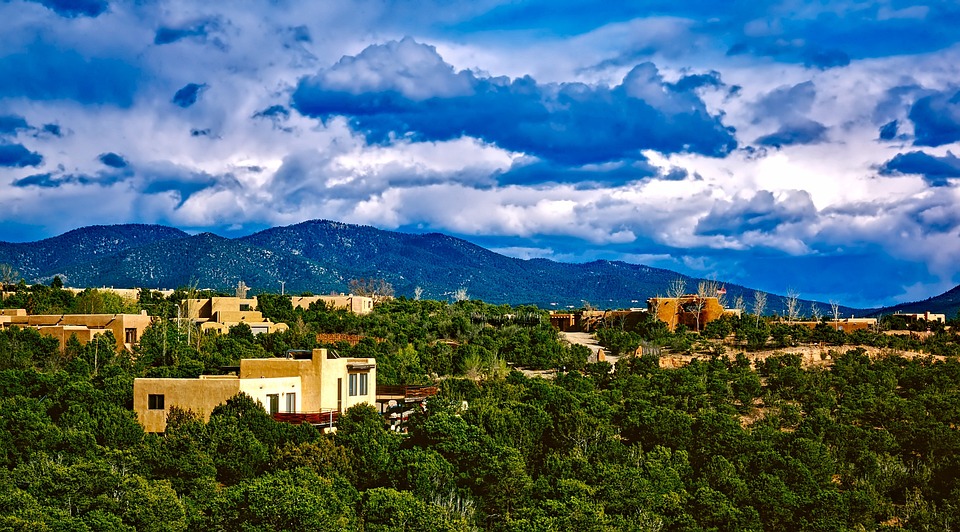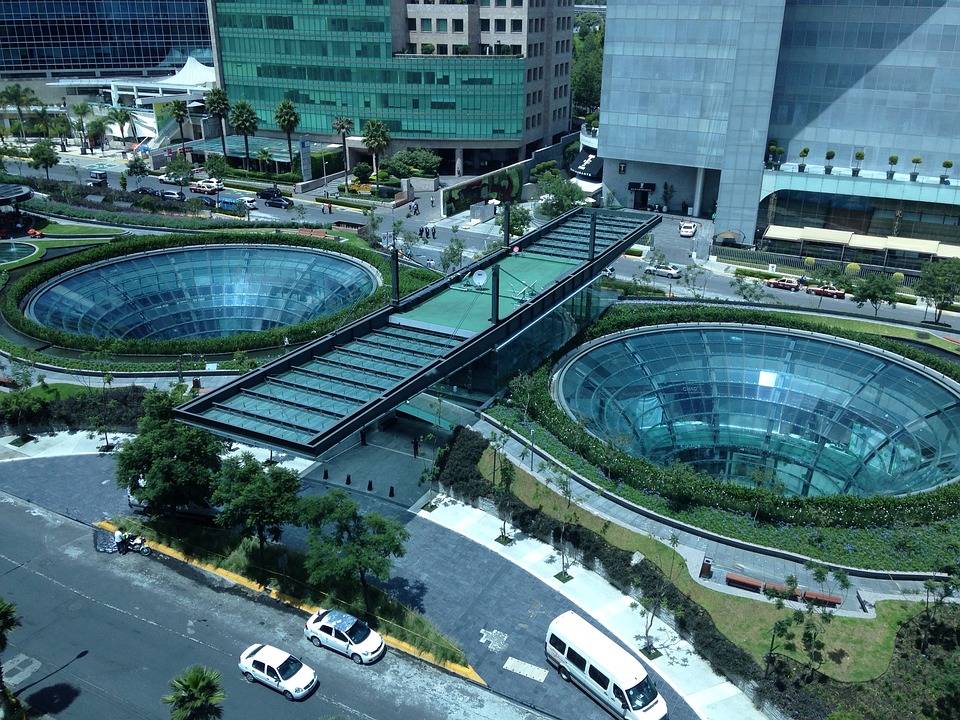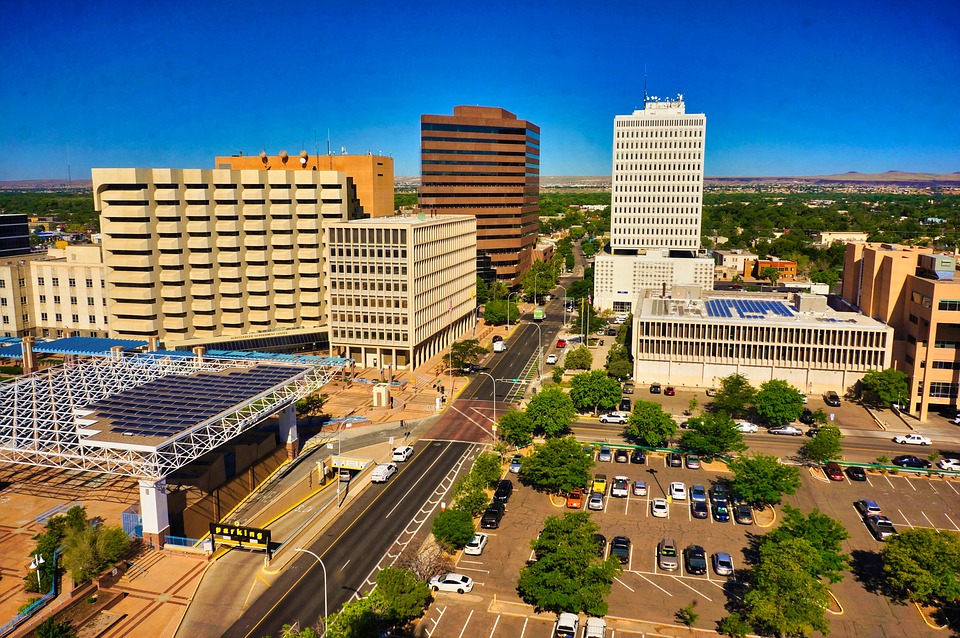New Mexico state (USA)

Location
The state of New Mexico is located in the southwestern United States and borders Texas to the east and southeast, Arizona to the west, Colorado to the north, and the state of Chihuahua in Mexico to the south. It is one of the so-called “Four Corners” states—a unique region where the borders of four U.S. states meet, giving it special geographical significance and appeal for tourists.
New Mexico is the fifth-largest state in the U.S., covering an area of approximately 315,000 km². The landscape features vast deserts, rocky mountain ranges, and high plains that shape the state’s distinct scenery. The main city and political center is Santa Fe, one of the oldest U.S. capitals, founded in 1610. The largest city, Albuquerque, located in the central part of the state, is the cultural and economic hub of New Mexico.
New Mexico’s highways connect the east and west of the country, giving the state strategic importance within the U.S. transportation infrastructure. For instance, Interstate I-40 runs across New Mexico from east to west, while I-25 connects the north and south.
Climate and Landscape
New Mexico’s climate is predominantly desert and semi-arid, with sharp temperature swings between day and night. Summer temperatures can reach up to +40°C, especially in lower regions, while winter nights often drop to 0°C or lower. Due to the state’s high average elevation, there are regions with a mountainous climate, where winter temperatures can drop even further, and summers remain relatively cool.
The state experiences relatively low annual precipitation, mostly as short but intense rain showers in the summer months, known as monsoon rains. Snowfall is also common in the northern mountain areas, where it supports a winter tourism season.
The landscape of New Mexico is impressive in its diversity, ranging from red sandy desert plateaus to coniferous forests at elevations over 3,000 meters. It features large plateaus, sandy dunes, rugged canyons, and famous mountain ranges such as the Sangre de Cristo and Sandia Mountains. New Mexico’s dramatic landscapes and vibrant colors have inspired many artists and photographers.

Population
New Mexico has a population of about 2.1 million, making it one of the most ethnically diverse states in the U.S. The demographic composition includes various cultural and ethnic groups, creating a unique social and cultural atmosphere. The population is divided among several primary racial and ethnic groups:
- Hispanic or Latino — approximately 49.3% of the population, mostly of Mexican origin, forming the largest ethnic group in the state.
- White (non-Hispanic) — about 37.0%. Predominantly descendants of European settlers, they make up the second-largest group.
- Native American — around 10.9%, with significant Navajo, Pueblo, and Apache communities, representing one of the largest proportions of Indigenous people among U.S. states.
- African American — about 2.6%, a relatively small part of the overall demographic structure.
- Asian and other groups — approximately 1.2%.
Crime
Crime remains a significant issue in New Mexico, particularly in certain areas of Albuquerque and other urban zones. According to recent data, the state ranks among the highest in the U.S. for crime rates per 100,000 residents. Common types of crime include theft, burglary, and vehicle-related offenses. High unemployment and social challenges in certain regions contribute to elevated rates of violent crime.
- Violent crime rate in New Mexico is approximately 778 per 100,000 residents, considerably higher than the national average.
- Property crimes are also prevalent, with a rate of around 3,420 per 100,000 residents.
State and local authorities implement various programs aimed at reducing crime, such as increasing police patrols in high-risk areas and supporting community-based initiatives. A key part of the strategy involves promoting social and educational programs for young people to reduce the likelihood of them entering a criminal environment.
Among major cities, Albuquerque is considered the most dangerous, while Santa Fe has a lower crime rate and a more peaceful reputation.
Economy
New Mexico’s economy is characterized by a diverse structure that includes mining, tourism, healthcare, education, agriculture, and manufacturing. Despite several economic challenges, the state plays an essential role in the U.S. energy sector, particularly through its oil, gas, and mineral extraction. Additionally, New Mexico is home to numerous scientific and military facilities, including Los Alamos National Laboratory and Kirtland Air Force Base.
Key economic indicators:
- Minimum wage in New Mexico is $12 per hour, with plans to increase it to $15 per hour by 2026.
- Median household income is around $51,945 per year, which is below the national average.
- Unemployment rate is approximately 5.3%, slightly above the national average.
Despite the lower median income, the state has various social support programs for low-income residents. One of the major sources of employment is the tourism sector, especially in cities like Santa Fe, known for its museums, galleries, architectural landmarks, and festivals.
Agriculture, including the cultivation of chili peppers, corn, and cotton, is also a vital part of the state’s economy, with products exported to other states and countries.
New Mexico for Business
Doing business in New Mexico offers distinct features related to state tax policies, economic incentives, and the presence of key industries. Although the state does not lead in national rankings for entrepreneurship, it provides unique opportunities and incentives, especially for the energy, defense, aerospace research, and tourism industries.
Major companies operating in the state:
- Intel – semiconductor manufacturing (notably, a large facility in Rio Rancho).
- Facebook – a large data center in Los Lunas, one of the biggest investments in the state.
- Virgin Galactic – aerospace company operating from “Spaceport America,” located in the southern part of the state.
- Los Alamos National Laboratory – a premier research facility focused on national security, energy, and technology.
Tax Advantages and Incentives
New Mexico offers several tax incentives to attract both local and international investors. Key advantages include:
- Reduced Corporate Tax Rate – for small businesses, the corporate tax rate starts at 4.8%, one of the lowest in the country.
- Job Creation Credit – companies can receive tax credits covering up to 30% of wage costs for each new employee hired.
- Incentives for Manufacturing Companies – tax benefits for manufacturers, particularly in high-tech and solar energy production.
- Film Industry Rebates – New Mexico actively promotes the film industry by providing a rebate of 25-30% on production-related expenses, making the state attractive for filming.
Business Considerations
Doing business in New Mexico can be advantageous for companies focused on the energy and technology sectors. Due to the availability of land resources, the state offers relatively low land acquisition and rental costs. However, there are challenges: the state has a relatively small pool of highly skilled labor in certain specialized fields, which may require companies to recruit professionals from other regions.
Despite these challenges, economic incentives and state support make New Mexico an appealing option for startups and innovative companies, particularly in sectors that require access to research labs, space facilities, or testing grounds.
Real Estate
The real estate market in New Mexico is known for its affordability compared to other western U.S. states. The median home price is around $293,000, which is below the national average. Demand for property is growing in cities like Albuquerque and Santa Fe, but remote areas also offer attractive options. The rental market is also appealing, especially for those looking for affordable housing options.
Key Real Estate Market Indicators:
- Median home purchase price: $293,000, with prices varying by city and neighborhood.
- Average rent: $1,150 per month for a two-bedroom apartment, though prices may be higher in Santa Fe and Albuquerque due to high demand.
- Popular areas for buying and renting: Albuquerque, Santa Fe, Las Cruces, and Rio Rancho, where there is an active market for both buying and renting.

Ecology
New Mexico’s ecology combines the unique nature of deserts, mountains, and plateaus, creating a distinctive ecosystem balance. The state preserves vast natural areas, including several national parks, reserves, and forests such as Carlsbad Caverns National Park and Gila National Forest. However, the environmental situation in New Mexico faces challenges related to mineral extraction, water scarcity, and wildfire risks.
Key Environmental Features:
- Water Scarcity – New Mexico is a dry region, and water conservation is critical for sustainable development. Water restrictions and resource management measures are in place.
- Impact of the Extractive Industry – oil, gas, and mineral extraction have a significant impact on the environment. State and local authorities enforce strict environmental regulations to mitigate these effects.
- Wildfires – due to the arid climate and high temperatures, especially in the summer months, wildfires are common and pose a threat to natural ecosystems and residents.
New Mexico actively works on environmental sustainability, implementing renewable energy initiatives like solar and wind power to reduce reliance on fossil fuels. The state government also supports conservation projects and efforts to combat soil erosion.
Notable Attractions
New Mexico is renowned for its rich history, culture, and natural attractions that draw tourists from around the world. From national parks and unique architectural sites to cultural events like the Albuquerque Balloon Fiesta, the state offers a wide array of fascinating destinations.
- Carlsbad Caverns National Park – one of the largest cave systems globally, famous for its stalactites, stalagmites, and underground lakes. This UNESCO World Heritage Site offers guided tours and special excursions for visitors.
- Taos Pueblo – a historic settlement of the Pueblo people, preserving traditional architecture and cultural heritage for centuries. It’s the only continuously inhabited site in the U.S. that is also a UNESCO World Heritage Site.
- Spaceport America – the first commercial spaceport in the U.S., where Virgin Galactic conducts launches and training for space tourists. The spaceport is open for tours, allowing visitors to learn more about space research and technology.
- Albuquerque International Balloon Fiesta – an annual festival and one of the largest hot air balloon gatherings globally. This ten-day event attracts visitors worldwide with its colorful displays, competitions, and night flights.
- Bandelier National Monument – a national monument featuring archaeological sites of Native American communities, ancient ruins, and beautiful hiking trails among canyons and cliffs.
These attractions are only part of New Mexico’s rich cultural heritage and natural wonders. The state is also known for its art scene, especially in Santa Fe, where visitors can explore numerous galleries, museums, and events dedicated to Native American culture and contemporary art.
Why People Move to New Mexico
New Mexico attracts new residents with its unique combination of natural beauty, cultural diversity, and affordable living conditions. The state offers a high quality of life for those who appreciate a relaxed pace, proximity to nature, and a variety of outdoor activities. At the same time, economic and cultural opportunities make New Mexico an appealing place for work and entrepreneurship.
Main Reasons People Choose New Mexico:
- Natural Beauty and Access to Nature – numerous national parks, mountains, and desert landscapes provide ideal settings for hiking, camping, and stargazing.
- Affordable Housing – the real estate market is more affordable than in many other western U.S. states, attracting young families looking for reasonably priced homeownership options.
- Cultural Diversity – the state is known for the cultural heritage of Native Americans, Hispanics, and Europeans, reflected in local festivals, traditions, art, and architecture.
- Investment in Infrastructure and Environmental Initiatives – New Mexico is actively developing renewable energy projects and implementing environmental initiatives, appealing to eco-conscious individuals.

Potential Drawbacks of Living in New Mexico
Despite the advantages, there are some challenges that new residents may encounter:
- Limited Job Opportunities for Highly Skilled Workers – although the state is expanding its scientific and technical sectors, certain professions may find limited opportunities.
- High Crime Rates in Certain Areas – particularly in Albuquerque, some neighborhoods have elevated crime rates, necessitating careful selection of a residential area.
- Water Scarcity and Arid Climate – many parts of New Mexico have a very dry climate, which may be challenging for newcomers unaccustomed to such conditions.
- Relative Isolation – while major cities provide all necessary services, some remote areas may have limited access to entertainment, shopping, and healthcare.
Table of Contents